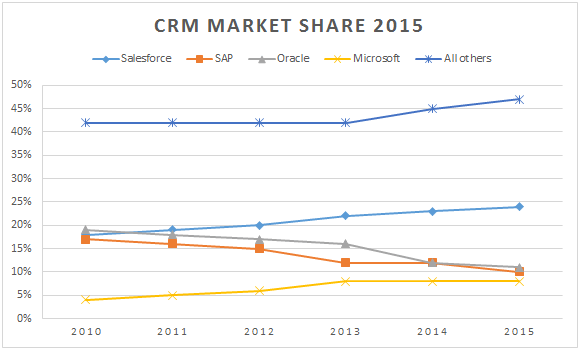Over the last four decades, CRM software has gone all the way from a basic database marketing solution to full-stack customer relationship management systems. We have witnessed the switch from on-premises systems to SaaS-based solutions and the rise of today’s top players of the CRM market as Oracle, SAP, Microsoft Dynamics, and, most prominently, Salesforce. Though the goal of the solution remained unchanged – to facilitate customer relationship management processes, the software has changed a lot during these years, acquiring new features and taking up new challenges. Let’s see how the CRM industry changed throughout the last decades and where it is headed today.
What CRM Was Like Back Then: Brief History Timeline
Early 2000s
By 2000, we had already had the first mobile customer relationship management platform – Siebel Sales Handheld, which would later be acquired by Oracle. Besides, by that time Salesforce had already been founded by Marc Benioff, a former Oracle executive, and a couple of other entrepreneurs. In 1999 the company introduced the first SaaS CRM, which then was primarily aimed at small businesses. Back then, few could imagine that Salesforce would grow to be one of the top CRM companies in less than a decade. Meanwhile, Microsoft was the leading CRM provider, with its MS Dynamics integrated with other legacy solutions, like MS Office and Outlook.
Mid-2000s
In 2004, SugarCRM introduced the first open-source CRM platform, making customer relationship management software accessible to a much wider range of companies.
During this time, Salesforce pushed the vision of a business world with no on-premises software which would give way to cloud-based solutions. In 2005, it introduced AppExchange, dubbed “eBay for business software” by BusinessWeek and “iTunes of business software” by Forbes. In 2007, Salesforce revolutionized the customer relationship management platform market by introducing its cloud-based CRM. The business community came to realize that CRM is not just a tool for managing client contacts but rather an all-around customizable solution that streamlines the work of both sales and marketing teams.
Late 2000s
At that time, more users worldwide got access to the Internet, and social media platforms gained popularity. Businesses came to realize that social media is a great tool in the hands of their sales and marketing teams, which allowed the start of the transition to social CRM. Salesforce was quick to pick up the trend, which was one of the reasons why it gained more market share and caught up with companies leading the customer relationship management field at the time – SAP, Oracle and Microsoft.
Early to mid-2010s
These were the years the platform introduced Marketing Cloud, mobile CRM solution Salesforce1, and Lightning – updated UI users had been craving for. Thanks to these and other innovations, in 2012 Salesforce became the major customer relationship management software provider and has managed to retain this position ever since.

The image was taken from www.crmsearch.com
Latest Trends in CRM
Just as CRM did a few decades ago, it helps companies manage their interactions with customers and consolidate ties with them. Only now it does this task far more efficiently, allowing for the evolution of business-client relationships. This would not be possible without customer relationship management software keeping pace with emerging technology innovations. Here are a few CRM trends that we think are going to rule the market in 2018.
The persistence of AI trend
A few years ago Marc Benioff, Salesforce CEO, took a gamble on artificial intelligence and started acquiring machine learning startups. Though not everyone approved of the move, to the point that the company lost 4% in its stock, it turned out to be a good bet. Now Salesforce is transforming into an AI-powered customer relationship management platform with more and more great features appearing with each release.
This year the trend clearly isn’t going anywhere. Moreover, despite the fact that numerous users have already discovered the benefits of Einstein AI, some are only starting to realize how advantageous artificial intelligence may be when applied to customer relationship management. So we can expect more AI features and add-ons, not just in Salesforce but other platforms too, and wider adoption of these features by CRM user base.
Switch from multichannel support to omnichannel
Though the difference may appear elusive, it does matter. Today businesses are using a variety of touchpoints at once to interact with their customers and gather feedback. Some might actually offer as many as six channels at once – phone, email, social media, self-service communities, live chat, video chat, or even more. Giving clients a wide choice of touchpoints might be a good thing, but at the same time it’s crucial that the customer get unified and consistent customer service on each channel they use. This drives client satisfaction up while making the performance of service teams more cost-efficient.
CRM on the go
In February Salesforce released a pack of Spring 2018 features. If you had a chance to look through over 400 pages of the release notes, you might have noticed that an impressively large amount of the new features are accessible through mobile devices too. The mobility trend isn’t new for customer relationshim management systems, however, with the screen size of mobile devices getting bigger and work schedules of sales teams getting more flexible, it becomes even more important that sales professionals have access to critical customer data wherever they are.
Make the Most of CRM
Since Salesforce is a CRM system that is evolving very fast and adding new awesome features almost every month, it might be challenging to figure out things that may be helpful for your business and make full use of them. We at OMI can give you a hand here. Our team has over two decades of experience working with Salesforce CRM. By following the industry’s best practices and introducing our own innovative solutions, we have acquired an impressive portfolio of Salesforce implementation, customization and custom app development projects. Whether you need to configure and customize your org’s interface, build a custom AI-driven reporting solution or create a Lightning-ready mobile application, OMI has the necessary expertise to accomplish these tasks. Get in touch to request a free, non-binding quote for your Salesforce project!
